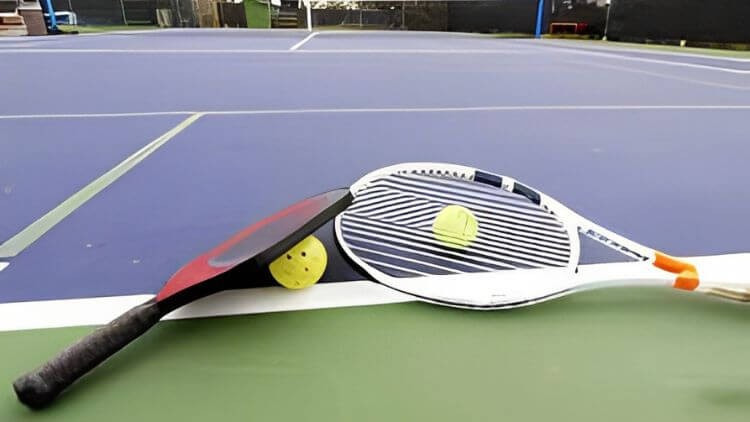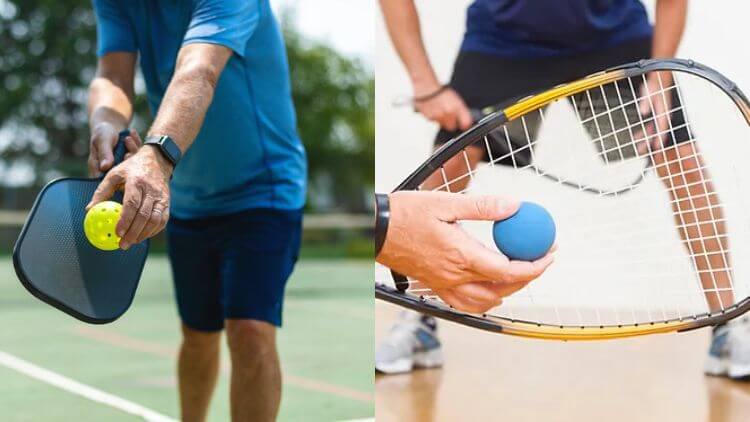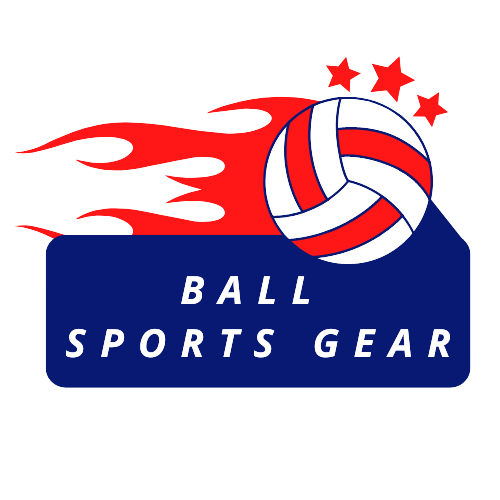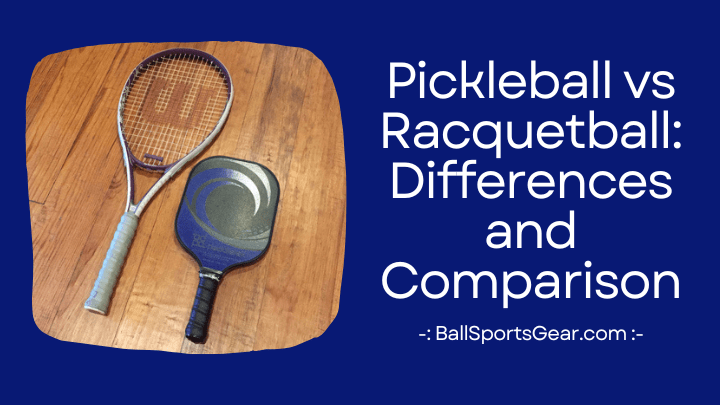Pickleball and racquetball have gained immense popularity as racquet sports, attracting players of all ages and skill levels. Despite both using paddles and a ball, they possess distinct qualities that differentiate them. Recognizing the discrepancies between pickleball and racquetball is crucial for individuals eager to delve into these thrilling games. This article will thoroughly explore the variations in gameplay, equipment, court layout, and other essential factors, offering a comprehensive comparison of pickleball and racquetball.
What Is Pickleball?
Pickleball, a relatively new sport, shares similarities with other paddle sports but has distinct characteristics that set it apart.
The game revolves around two or four players hitting a pickleball back and forth using small paddles on a court similar in size to badminton. While the rules are straightforward and the game lacks complexity, beginners may need some time to adjust to the nuances that make pickleball an exciting sport to play.
What Is Racquetball?
Racquetball is an enjoyable and engaging cardio workout that provides players with the opportunity to strategize while on the court.
Compared to other racket sports like tennis or badminton, racquetball offers a more social experience as players are in constant contact with each other throughout the game. This aspect makes it less intimidating and fosters a sense of camaraderie, as players can be confident that their opponent won’t surprise them with unexpected ball hits.

Doubles play in both pickleball and racquetball emphasizes teamwork and collaboration, with partners taking turns to make moves. This approach fosters mutual reliance and ensures that both players actively contribute to the game, rather than one player dominating while the other plays a secondary role.
Pickleball vs Racquetball: What’s the Difference?
Now, let’s dive into the dissimilarities between racquetball vs pickleball, examining key aspects such as the serve, scoring system, paddle, ball, court, and net. By exploring these variations, we aim to offer a comprehensive understanding of the distinctive features that make each sport unique and special.
Serve:
Pickleball is an engaging ball sport where two players utilize a paddle to volley a small pickle-shaped ball across the court. The objective is to skillfully maneuver the ball and strike the opponent’s paddle away while strategically maintaining a central position on the court.
In contrast, racquet sports like tennis, squash, and golf share certain similarities but employ a racket instead of a paddle. The key distinction between Pickleball and Racquet sports lies in the player’s grip on the paddle. In Pickleball, players employ a one-handed grip on each paddle to strike the ball, departing from the conventional double-handed style commonly seen in other sports.
Similar to a pickleball paddle, a racquet serves a comparable purpose, requiring one hand to strike the ball while the other hand firmly grasps the racquet. The choice of hand for striking the ball can be based on personal preference.
Scoring:
Scoring holds immense significance in determining the outcome of any sport. However, there exists a distinct contrast in the scoring systems of pickleball and racquetball. In pickleball, matches are played up to 11 points, with players serving for two points consecutively. On the other hand, racquetball matches extend to 15 points, with players serving one point at a time. But what is the rationale behind this scoring disparity?

Paddle:
Racquetball racquets are usually 22” long and have a stringbed that extends to fill about 70% of the racquet’s length and 95% of the racquet’s width. Recreational racquets are made up of aluminum, and performance frames are typically 100% graphite frames. Racquetball racquets are weighed in grams, not ounces. Most racquets weigh between 160-180 grams unstrung, and around 185-205 grams strung.
Pickleball paddles typically feature a combination of lightweight and durable materials such as a honeycomb core, polymer, graphite, fiberglass, carbon fiber, among others. They fall somewhere between the size of a ping pong paddle and a padel paddle, with widths ranging from 12-18mm and lengths of around 15-16 inches. The weight of pickleball paddles usually falls between 7-8.5 ounces.
Ball:
The type of ball used distinguishes pickleball from racquetball. In pickleball, a plastic ball with small holes, reminiscent of a wiffle ball, is utilized. This ball is specifically designed for lower bounce, facilitating precise control and slower-paced gameplay. On the other hand, racquetball employs a small rubber ball with a higher bounce. The increased bounce of the racquetball allows for swift shots and strategic maneuvers that rely on the ball rebounding quickly off the walls.
Court:
Pickleball courts and racquetball courts are starkly different from each other. Pickleball courts are typically found outdoors, measuring 44 feet in length and 20 feet in width. They feature a net standing at a height of 36 inches. These courts are marked with specific lines indicating where the serve should land, as well as boundaries along the sidelines and baseline where the ball must either land on or inside. Additionally, there is a designated non-volley zone that players must avoid unless the ball has bounced within it.
In contrast, traditional racquetball courts are situated indoors, commonly within gymnasiums or health clubs. These courts consist of four walls, a ceiling, and a door for entry. Once inside, the rules become more flexible during rallies, as long as the ball hits the front wall before the floor. However, the serve follows different regulations. Racquetball courts are 40 feet in length, 20 feet in width, and stand 20 feet tall.
Net:
In pickleball, the objective is to clear the ball over a net, while racquetball does not have a net. As a result, racquetball players tend to hit shots in an upward and downward trajectory rather than side to side as in pickleball.
This distinction in shot placement, with shots going up or down, contributes to the excitement of racquetball as a sport. However, it also presents a challenge when transitioning from other sports. The spinning and contact points in racquetball require more power in shots hit upward compared to tennis, adding to the complexity of adjusting to the game.
Frequently Asked Questions
Racquetball players transitioning to pickleball often have an advantage due to their skills and experience in racquet sports. The physicality and quick reflexes required in racquetball can transfer well to the faster-paced nature of pickleball. Additionally, racquetball players are accustomed to playing on more open courts, allowing them to utilize strategic shots and adapt to the larger playing area in pickleball.
Despite its exciting gameplay and physical demands, racquetball has struggled to achieve the same level of popularity as other sports like tennis. One reason could be the lack of exposure and media coverage compared to more mainstream sports. Additionally, the need for specialized courts and equipment, as well as limited availability of racquetball facilities, may hinder widespread participation. Racquetball’s distinct rules and unique gameplay style may also contribute to its niche appeal.
No, pickleball cannot be played in a racquetball court. The two sports have different court dimensions, equipment, and ball specifications. Pickleball is typically played on smaller outdoor courts, while racquetball is played on enclosed indoor courts. Attempting to play pickleball in a racquetball court would not only compromise the gameplay experience but also pose safety risks due to the differences in court size and design.
Conclusion
In conclusion, while pickleball vs racquetball are both popular sports, they have distinct characteristics. Pickleball is typically played outdoors on a hard surface, whereas racquetball takes place indoors on a soft surface. These differences between racquetball vs pickleball contribute to the unique experiences offered by each sport.

